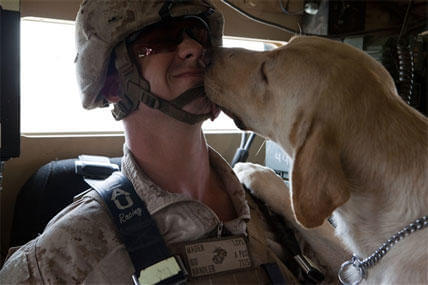HELMAND PROVINCE, Afghanistan – Riding in an armored truck over Afghanistan’s rutted dirt roads is scarcely a smooth or comfortable experience.
Each bump is felt as springs groan and creak under the weight of the mine resistant, ambush-protected vehicle. The air conditioner circulates dusty air, and unless you’re right next to the vents, you’re drenched in sweat. Body armor weighs down on shoulders and compounds the pain of sitting in one spot for hours on end.
For Marine Corps Lance Cpl. Stephen Mader and his dog Maxx, this experience is routine. Mader is an improvised explosive device detector dog handler with 3rd Battalion, 8th Marines, Regimental Combat Team 6.
Their MRAP hits a large bump, and water in a metal dish near the truck’s back entrance splashes onto the floor. Maxx, who was dozing, stands up, puts his front paws on Mader’s lap and nuzzles his head against Mader’s body armor. Mader wraps his arms around Maxx, gives him a pat on the side and a scratch behind the ears, and reassures him everything is all right. Maxx settles down with his chin across Mader’s boots – his spot – and closes his eyes again.
“It’s basically like having a 3-year-old in Afghanistan,” said Mader, who is responsible for every aspect of Maxx’s care. He feeds him, cleans him and even monitors Maxx’s behavior for signs of stress or fatigue.
And like a 3-year-old, Maxx, a yellow Labrador, always wants attention.
“Otherwise, he’ll start licking me,” Mader said.
Mader and Maxx have been together for seven months since they met at the five-week IED detector dog handler school in Southern Pines, S.C. The dogs come to the school trained to obey commands and track explosive scents. Human students go to learn how to handle the dogs.
School instructors interviewed Mader about his demeanor and personality and asked questions such as, “Are you laid-back or a hard-charger?” to get an idea of which dog to assign him. Mader said he’s a mix of both.
Mader, who joined the Marine Corps in 2009, said the dogs need a good rapport with their handlers. If there is a personality clash, the dog won’t perform. Maxx is a perfect match, he said.
“If I want to be playful and active, he will be,” Mader said. “But, if I want to relax, he’ll lay down next to me.”
Overall, Maxx, who is actually 4 years old, is “pretty chill” and will sleep when he’s not working, Mader said. But, Maxx does have his wild streaks, he added. The dog likes to break out of his kennel and to try to swim in the canals in the southern Helmand River Valley, where the battalion’s personal security detachment often travels.
“He’ll try, and I’ll have to stop him,” Mader said.
Unlike some military working dogs, IED detector dogs are not trained to be aggressive. Their handlers have the discretion to allow other Marines to approach or pet their dogs. Maxx is popular with the Marines and gets a lot of attention, Mader said, but when it comes time to work, he’s ready to go.
“In the truck, he’s like a pet, but whenever we’re out there, he’s like a tool,” he added, noting that IED detector dogs are “a great tool to have if you use them correctly.”
The duo spends a lot of time on the road. Mader said Maxx can sense where they are.
“It’s weird, but he’ll know what [forward operating base] we’re going to,” he said. When they’re getting close to FOB Geronimo, a larger, more built-up base, Maxx gets excited and starts pacing. When they approach a smaller, more austere place such as Combat Outpost Rankle, “he’ll just lay there,” the dog handler added.
When Mader and Maxx aren’t on the road or working, they’re training. After missions, while other Marines are relaxing, Mader is making sure Maxx’s tracking skills stay sharp. Maxx is trained with a rubber bouncy toy called a “bumper,” used as a reward for performing a task successfully. When the bumper comes out, it’s a morale boost for the dog, Mader said.
Even with the long hours and the extra responsibilities of being a dog handler, Mader said, it’s “the best thing to happen to me in the Marine Corps.”
After this deployment, Mader said, he would volunteer to be a handler again if there is a need and an opportunity. He is an infantry mortarman by trade.
“I love being with the dogs,” he said.
As the Afghan army continues to take over more of the security responsibilities here, officials at Marine Corps Systems Command said they anticipate the number of dogs to be reduced in the near future, correlating with the reduction in Marine forces in the region. If Maxx is no longer needed, Mader said, he wants to adopt him.
“I don’t want to give him up,” he said. “I’ve bonded too much to give him up.”
Mader looks down at Maxx, still asleep across his boots, unaware of the potential dangers outside their MRAP. The occasional hard bump in the road is the only thing that stirs him from his nap on this ride. However, if needed, the pair will be ready to go on a moment’s notice to track down the scent of any explosives on the route to prevent vehicle damage, injuries or worse.
“A local kid asked if he could buy Maxx for $10,” Mader said. “I had to tell him he’s worth a little bit more than that.”


























